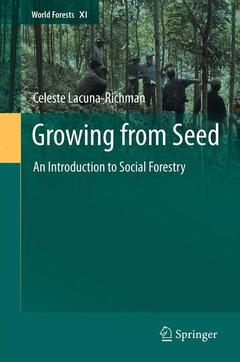Description
Growing from Seed, 2012
An Introduction to Social Forestry
World Forests Series, Vol. 11
Language: English
Subjects for Growing from Seed:
Publication date: 11-2013
100 p. · 15.5x23.5 cm · Paperback
Publication date: 10-2011
100 p. · 15.5x23.5 cm · Hardback
Description
/li>Contents
/li>Comment
/li>
Social Forestry and its most well-known variant, Community Forestry, have been practiced almost as long as people have used forests. During this time, forests have provided people with countless goods and services, including wood, medicine, food, clean water and recreation. In making use of forest resources, people throughout history have frequently organized themselves and established both formal and informal rules.
However, just as the discipline of Forestry had previously limited and concentrated the function of forests to the timber it provides, the popular understanding of Social Forestry has restricted it to a Forestry sub-topic that deals with welfare, without any connection to income-generation, and is practiced only in developing countries.
This volume introduces the concepts of Social Forestry to the student, gives examples of its practice around the world and attempts to anticipate developments in its future. It aims to widen the concept of Social Forestry from a sub-practice within Forestry to a practice that will make Forestry relevant in countries where wood production alone is no longer the main reason for keeping land forested, thereby rediscovering and redefining this important topic.
1. Introduction: Basic concepts of social forestry.- 2. People and Forests: The relationship betweensociety and natural resources.- 3. Communities in Tropical Forests: Examples of cultures and societies that depend on the forests for their livelihood and sustenance.- 4. Participation: The methodology of social forestry.- 5. Tailoring forest management to fit local needs. 5.1 Nutrition, food security and livelihood needs. 5.2 Gender, class, religion, age, cultural traditions and other ”unchangeable” factors that affect the use of the resource. 5.3 Land tenure and resource constraints. 5.4 Cooperatives and other community organizations.- 6. Effects of External Organizations on the Community’s Practice of social forestry.- 7. Alternative Strategies: Adapting to new, unplanned circumstances.- 8. A social forestry approach in Europe.- 9. Concluding Remarks.




